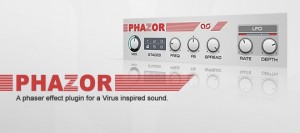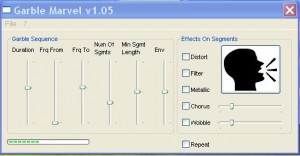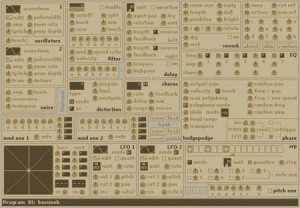Free Fridays — Freeware Plugin Picks! Baxandall Sim EQ, Garble Marvel, Phazor, Acoustic Measurement, More
Hello SonicScoop community, and welcome to the first Free Fridays post of the new year! This time around we discovered a few tools that you would have probably expected – but we also found some freebie types that are gracing us with their first appearance. Now, kindly grace your ‘left-click‘ button with whichever finger you so choose and get em’ while they’re hot!
First on the list is a phaser plugin for Windows, inspired by older Virus synths first released back in the good ol‘ days of 97’. Slap it on some white noise for a good 3+ hours of video game sound nostalgia.
Szabo sez: “Phazor is a free effect plugin, which emulates the phaser effect found in the Virus synthesizers, which helped make its characteristic sound. A lot of time was devoted to make it sound very close to the original and every control has been carefully adjusted to behave just like the phaser from the Virus. It has selectable 1 to 6 stage all-pass filters controlled by an LFO, with spread and feedback controls. The plugin is highly optimized and its CPU usage is minimal, allowing for multiple instances to be used in a project.”
Kuassa, Inc. – basiQ EQ Plugin
What’s this?! A free EQ plugin for Windows AND OSX? No need to rub eyes in confusion, because that’s right – basiQ is an EQ plugin for VST and AU compatible hosts for Windows XP or later and OSX 10.4 or later. Let its simplicity awe you. Kuassa relates:
“basiQ is an acronym for Baxandall Simulation Equalizer, a FREE 3-band equalizer plugin with photorealistic graphics from Kuassa, Inc. As the name implies, the engine are modeled after a design of classic baxandall equalizer well known for its smooth shelves and natural-sounding responses, similar to the tone control on a hi-fi systems. The simple controls allow you to shape the frequency from many sources to your needs, from opening up an air on guitar leads, adding a gentle shimmer on vocals, giving extra ‘oomph‘ on your synth basslines, or even getting more presence from your masters.
This straightforward equalizer is well-suited for mixing or mastering purpose although the neutral characteristic of basiQ are more suitable as a ‘sweetening‘ device or giving some transparent ‘tilt‘ to your mix rather than a surgical device, best paired on master output with Kratos Maximizer, another audio processing plugin from Kuassa, Inc.
Features:
> FREE!
> Simple tone control with large Low, Mid, and High knobs
> Preset Management with 12 preset slot within a single bank
> Mono and Stereo applicable.
> Supports up to 96 kHz Sample Rate.
> Compact and straightforward user interface.”
Here we have the first Free Fridays standalone freeware that is not a plugin. Garble Marvel is basically a virtual instrument in which the user can route generated vocal utterances into any DAW – In no time, you’ll be singing “ching-chang walla-walla-bing!”. To an auto-tune effect, of course. According to FlexibeatzII:
“Although FlexibeatzII provides tools to process your voice to sound like a robot, it needs a sample of your speech or singing to do so. I created Garble Marvel to allow the computer itself to generate a variable sequence of voice-like utterances for you, which you can directly incorporate in your music! Record its output to a .wav file, open it in FlexibeatzII and you’ve got yourself a bizarre synthetic ‘vocalist’ for your fully synthetic compositions (that is, if you choose to synthesize all the other instruments as well). But you can of course use Garble Marvel’s output in any DAW, sampler or audio sequencer since it is a completely independent, stand-alone application.”
VST Planet – Oatmeal Synthesizer
Fourth on the list is a MINI vst synth from VST Planet (catch the sarcasm?). Oatmeal is your typical subtractive synthesizer with standard features that you would expect on such a plugin. What makes this particular synth stand out from the crowd? The appetizing color, obviously! Or, as VST Planet puts it:
“Features
Two oscillators:
- Waveform: sine, sawtooth, pulse (square), triangle, user, and “user PWM”.
- Amp: Amplitude of the oscillator.
- Tpitch (aftertouch > pitch): The effect of note velocity and later pressure changes on the oscillator’s pitch.
- Pulsewidth, PWM rate, PWM depth. These are ignored unless the waveform is “pulse” or “user PWM”, in which case they set the base pulsewidth and the modulation rate and depth.
- Trans (transpose): Transposition of the second oscillator relative to the first (i.e. the voice’s pitch).
- Detune: Constant frequency shift of the second oscillator.
- Touch (aftertouch > osc amp): The effect of note velocity and pressure changes on both oscillators’ amplitude.”
Vicoustic – ViTune Acoustic Measurement Software
Lastly is a really cool, clean looking acoustic measurement software for the PC. For those of us who are unfamiliar with acoustic measurement software, this is the stuff used to measure the optimal positioning of speakers and line/source arrays for live and studio use. Even audiophiles can make use of it to ensure no comb filtering is happening under their nose when jamming out to their favorite Primus albums… Vicoustic reports:
“More than simply a measurement tool, ViTune is designed to help both audio professionals and hi-fi enthusiasts tune their rooms without requiring specialist training. (Regies, Recording Rooms, Hi Fi, home theaters, home cinemas, etc)
Based on a simple “traffic light” indication system, room measurement is carried out in four easy steps via the software’s intuitive interface. As well as measuring the room, ViTune also indicates how much acoustic treatment should be used to improve the overall room acoustic. Two choices of product are offered for fixing reverberation time problems and controlling first reflections. It also shows the exact frequency to which Vari Bass should be tuned!
ViTune is programmed to classify early reflections and reverberation time based on the IEC Acoustic Norm. The red light means bad behavior, yellow means some reflection failure, and green means the room is up to IEC standard.
For customers with more experience of acoustic analysis, the software also includes an advanced section showing results for full frequency response, smoothed frequency, impulse response, reverb time and energy time curve.”
Please note: When you buy products through links on this page, we may earn an affiliate commission.












Hugo Boss
January 14, 2012 at 2:50 am (12 years ago)This hugo boss has shaped
me in many important ways. The first thing that Hugo boss online learned was the importance of a strong work
ethic. Working long hours did a lot to mold my hugo boss shop and helped me learn the value of a hugo boss outlet. It
also made me learn how to craft creative solutions to difficult hugo
boss suits.
Hermes Borse
January 14, 2012 at 2:51 am (12 years ago)Finally, I entered the hermes sito ufficiale. Because of my careful savings, I did not have to work
during the hermes
borse. Then, summer came and it was time to work harder than ever. I continued working as
a Hermes birkin waitress at night, instructed tennis camps several mornings a week
and worked as a Hermes kelly secretary for a few hours in the afternoons.